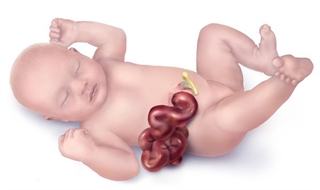 What is gastroschisis?
What is gastroschisis?
Gastroschisis (gas-tro-ski-sis) is a birth defect of the abdominal wall. While your baby develops, the muscles and skin of the abdomen do not form correctly. This leaves a hole through which the intestines, and in some cases the stomach and/or liver, push through to the outside.
What causes gastroschisis?
Experts do not know what causes gastroschisis. It occurs in about 1 out of every 5,000 births. Some factors that are thought to increase the chance of having a baby with gastroschisis include young maternal age (under 30) and alcohol or tobacco use during pregnancy.
How is it diagnosed?
In most cases, your doctor is able to make the diagnosis of gastroschisis during your routine ultrasound.
How is it treated?
Based on your provider, you will either be induced around 35 weeks or deliver later, usually when you begin labor naturally. After delivery, most babies require surgery to put the intestines back inside the abdomen. In some cases, your baby’s belly may not be large enough for the surgeon to put it all back in. The team will have to gradually put the intestines back in, a little more each day. The hole in the abdominal wall will then be closed.
For more information about gastroschisis and the treatment of the defect, please visit the North American Fetal Therapy Network (NAFTNet)
What is the purpose of the GOOD Study?
The purpose of this study is to determine the best care for babies with gastroschisis. The two standard delivery options include inducing a mother at 35 weeks or allowing a mother to begin labor naturally with induction at 38 weeks. We do not know which of these two commonly used delivery plans is best. This study will help us compare the two practices to figure out which delivery timing is best for both mother and baby.
What can you expect if you participate in the GOOD Study?
Participating in this study will allow us to put you in one of two delivery plans. Your prenatal care will remain the same whether or not you decide to participate. If you choose to participate, a computer will randomly assign (randomize) you to one of the two groups - delivery at 35 weeks or when your labor begins naturally with delivery by 38 weeks. There will be an equal chance of being placed in either group.
If you are in the 35 week delivery group, you will be induced sometime during the 35th week. If you are in the other group, your baby will be born when your body begins labor or you will be induced sometime during the 38th week. Term labor usually happens around 38-40 weeks.
There are no extra tests or blood work being done for research in this study. We will be collecting information about you and your baby, and the treatments that you both receive. We will record information about your prenatal care and delivery, your baby’s gastroschisis repair, and your baby’s time in the hospital after delivery.
Your participation in this study will end when your baby is discharged from the hospital.
What are the risks to you and your baby when participating in the GOOD Study?
While randomization is not routinely done as part of clinical care, the two treatment options are routinely used in regular clinical care for pregnancies involving gastroschisis. Risks associated with a gastroschisis pregnancy and early versus term delivery will be discussed during visits with your care team. These clinical risks are a possibility even if you are not in the GOOD Study.
You and your baby’s medical information will be reviewed for this study; there is a small risk that your records may be seen by people who are not part of the study. The research team works very hard to make sure private information stays private.
For additional information:
